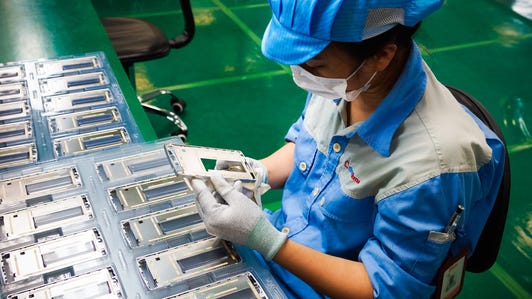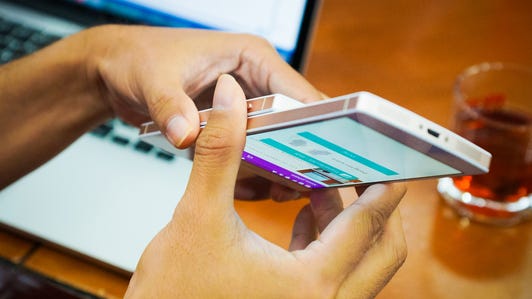
HANOI, Vietnam — The lights in the conference room flickered a couple of times and then turned off completely. The hum of the air conditioner quieted and the room became still — unnaturally so for a technology company trying to enter the noisy smartphone business.
I was at the Hanoi headquarters of BKAV, a Vietnamese company that’s made its money selling security software but now wants a piece of the $2.2 billion smartphone market here. The electricity in the building — located around the corner from the city’s tallest skyscraper, the Keangnam Hanoi Landmark Tower — sputtered in the middle of a presentation about the company’s first phone. I’m told it “happens sometimes.”
In early June, a few weeks before I arrived here, BKAV launched the Bphone, which it touts as the first smartphone designed and made in Vietnam. The sleek device, which comes in six models and costs about $450 to $925, is reminiscent of an iPhone 4 — but with a bigger, 5-inch screen versus Apple’s 3.5-inch display.
BKAV’s mission is part of a technological revolution happening in Vietnam. Most of the investment in the country, however, has come from foreign companies looking for ways to more cheaply build their gadgets. That’s why BKAV stands out; it’s a homegrown company with the goal of building a pricey phone for locals. In some ways, it’s following in the footsteps of China’s Xiaomi, which built up global credibility for its low-priced smartphones by catering to its home market first.
BKAV’s sights, though, are squarely aimed at the premium market.
Making a high-end smartphone “is the dream for every high tech corporation in the world,” said Ta Minh Hoang, the BKAV mobile product director who led development of the Bphone. “Making a smartphone is also our dream because we want to become the best technology corporation in the world.”


Shara Tibken/CNET
The Vietnamese aren’t afraid to spend money on electronics. Last year, 24 million mobile phones were sold in Vietnam (the population totals about 94 million), according to Strategy Analytics. Smartphone demand is expected to soar here over the coming years.
Sounds great for BKAV, right? The problem is the Vietnamese aren’t clamoring for a “made-in-Vietnam” phone. They’re happy with their iPhones and the Galaxy devices offered by Samsung. With workers typically making less than $150 a month, the Bphone is too pricey for many. The boastful nature of BKAV’s CEO — who calls Bphone the best smartphone the world — also goes against the grain of typical Vietnamese humility and has turned many people off. Others are skeptical the company actually designed and manufactured the Bphone here.
“If you can’t prove that you make any hardware parts and can’t show where your factory is located, then how can it be made-in-Vietnam?” a user identifying himself as No Banh Nha Lau commented on an article about Bphone in May.
Designed in Vietnam
But it was that very factory where I headed next. A run-down industrial complex covered with green corrugated metal, just a 10-minute drive away from BKAV’s headquarters, is home to one of two facilities where BKAV workers build the Bphone.
When I visited BKAV’s phone assembly plant, about three dozen people were suited up in blue-and-white uniforms. Think a cross between doctor scrubs and mechanic garb. Everyone wore white cloth gloves, surgical face masks and blue cloth hats with rims to keep strands of hair from falling on the smartphone parts.
Building Bphone: Inside BKAV’s phone assembly factory (pictures)






The workers sat on rolling office chairs in front of small green assembly lines that resembled long, skinny ping pong tables. Each was tasked with a part of the process, which included dusting off the components or snapping on the backplate of the smartphone. Normally, there are about 100 people in that factory, but I arrived at lunchtime.
Another 50 people work at BKAV’s mechanical factory nearby, creating Bphone parts like the metal body, SIM card holder and speaker box. They also build device prototypes and models of other components before hiring partners to manufacture them. BKAV plans to open a bigger factory in the Hoa Lac Hi-Tech Park in suburban Hanoi, about 30 kilometers from its current factories, “when we get good feedback from the market,” said Vu Thanh Thang, vice president and director of BKAV’s hardware division.
BKAV spent about $20 million, relied on 200 engineers and took four years to develop its first smartphone. It designed everything from the motherboard housing the phone’s components — including a high-end, but older, Qualcomm processor — to the device’s exterior to the software that runs on top of Android, Google’s mobile operating system software that powers the majority of phones in the world. The Bphone Operating System, or BOS, comes packed with many BKAV-designed apps, including a browser (Bhrome) and a dialer/Internet-based calling app (Btalk). Another key feature of BOS: Its antivirus software.

 Enlarge Image
Enlarge ImageShara Tibken/CNET
BKAV uses the “made-in-Vietnam” label as one of Bphone’s biggest selling points.
“We want [to show] that Vietnam can do the high-grade products like America or Japan or Korea,” said Bach Thanh Le, BKAV’s vice president and chief information officer.
But it’s the use of components from foreign companies that has tripped people up. Before the device hit the market, some questioned whether Bphone was really made and designed in Vietnam or whether the smartphone was actually a Chinese device. Other Vietnamese vendors, such as MobiiStar, have contracted Chinese manufacturers to design and build smartphones that they slap their brand on. And there’s a debate over whether a company can claim a phone is “made in Vietnam” or any other location if it uses components from other places, like that Qualcomm processor.
“Why do some people think that Bphone is not really a Vietnamese phone?” BKAV CEO Nguyen Tu Quang said over e-mail. “Because it’s hard to believe that Vietnam can design and manufacture a world’s leading smartphone.”
‘Explosive Quang’
BKAV’s 40-year-old CEO isn’t what you’d call modest. He built the first version of his BKAV antivirus software as a third-year university student in 1995 and formed his company to commercialize the software a decade later. Today, BKAV is one of the biggest security software companies in Vietnam, with a branch in Mountain View, California — the heart of Silicon Valley.
More on Vietnam
- Schooling Vietnam: How tech companies are training the next wave of workers
- Why Flappy Bird was just the start for Vietnam’s startup scene
- For startups in Vietnam, independence has its challenges
- Misfit CEO Sonny Vu on Vietnam’s modern-day success story (Q&A)
Quang has a reputation as a workaholic, and he’s well known by his nicknames — “Explosive Quang” and “Quang the bomb thrower” — due to his boastful nature.
When he first teased the Bphone in January at the Consumer Electronics Show in Las Vegas and again when launching the device in May, Quang called it “unbelievable” and a “masterpiece.” He dubbed it the world’s best smartphone.
“I strongly believe that when holding it in your hand, you’ll think like me: one of the world’s most beautiful smartphones,” Quang said at the May event, according to the English subtitles of a BKAV video.
Quang dismisses the criticism, saying talking up a company’s products is the job of a CEO, even if doing so is not popular in Vietnam.
For some, the hype has worked. Nguyen Viet Phu — a 41-year-old Hanoi resident who works for Vietnam Television, the country’s national broadcaster — bought a 64-gigabyte champagne-colored Bphone as soon as it became available. He wanted to see what a Vietnamese phone would be like after he lost his iPhone 5S.
“Bphone really is a beautifully designed phone,” he said over e-mail. “I am very satisfied with the device.”
For others, Quang and BKAV’s bluster has backfired. And countless others in Vietnam aren’t even aware the Bphone exists. A couple looking at smartphones in a large electronics store near Hanoi’s posh French Quarter said they’d never heard of the device.
Apple, Samsung mania
BKAV’s lower profile is a critical problem. Even heavy hitters of the past like Nokia and Sony draw more interest.
But Apple and Samsung displays are often the first thing buyers see when they walk through the doors of electronics stores. Nearly every block in Hanoi, the capital of Vietnam, has a store hawking the iPhone or using the Apple logo to draw in customers. Dang Dung Street in the center of the city features pawn shop after pawn shop selling — what else? — iPhones and iPads. The Apple logo appears on everything, from motorbike helmets to the bright pink hoodie worn by a female tailor in Hoi An. This is pervasive, even though Apple doesn’t have a store in Vietnam.

 Enlarge Image
Enlarge ImageShara Tibken/CNET
“I don’t have the money right now, but if I have the money, I want to buy an iPhone,” Dao Dat, a 20-year-old who’s working part time while learning English to become a teacher’s assistant, said through an interpreter at the VinPro store. He’d have to save for a year to afford an iPhone 6.
Just as prevalent are stores selling Samsung devices, and billboards from the South Korean company line the roads. Samsung has invested nearly $9 billion over the past seven years to build Vietnamese facilities to assemble its latest devices. More than half of the smartphones sold in Vietnam in the first quarter came from Apple and Samsung, according to Strategy Analytics.
Nowhere near as ubiquitous is BKAV. The company’s challenge is to convince people to ditch their favorite brands for a made-in-Vietnam phone, while forking over hundreds of dollars for it. BKAV executives claim Bphone buyers get a high-end phone at half of what they’d pay for an iPhone or Galaxy S device. But if you’re going to shell out hundreds of dollars, why not hold out for the flashier brand?
“The price is way too high,” a user named Anh Tuan posted online, as translated to English from Vietnamese. “I’m a patriot and willing to support made-in-Vietnam products as long as the value meets the cost. Don’t let the love for your country be used as a marketing ploy.”
BKAV’s limited rollout could hurt Bphone’s prospects. Vietnam is a country where most consumers buy their devices in physical shops, while in China, Xiaomi has sold millions of devices by holding flash sales on the Web. BKAV only offers its device online, and it’s selling Bphone in phases. The first batch went on sale June 2, and the second will take place in August.
Meet BKAV’s made-in-Vietnam Bphone (pictures)






BKAV sold 11,822 Bphones during its first go-around, but that’s a sparse compared with the 2.1 million handsets Xiaomi sold during a 12-hour flash sale in April or the 10 million iPhone 6 and 6 Plus units Apple sold in the first weekend they were on the market in 2014.
Generating high sales volume isn’t the main priority, said BKAV executives, who say they also value the importance of making a good impression. The company offered a two-week return policy to give customers time to try out the device — something that’s virtually nonexistent in Vietnam, where most sales are final.
But sales eventually will have to matter if BKAV intends to stay in the market for the long haul. Looking ahead, it wants to go after other markets in Asia, such as India, and possibly even the US within the next year or so. The company has enlisted Qualcomm to help it work with wireless carriers including Verizon and AT&T, the top two carriers in the US.
“The global market is our final goal, you see, as Apple or Samsung [has done],” Le said. But “if the domestic market is not good, we cannot have the basic requirement to go forward. So in the near future, we have to convince the Vietnamese people to believe [in] this product.”



